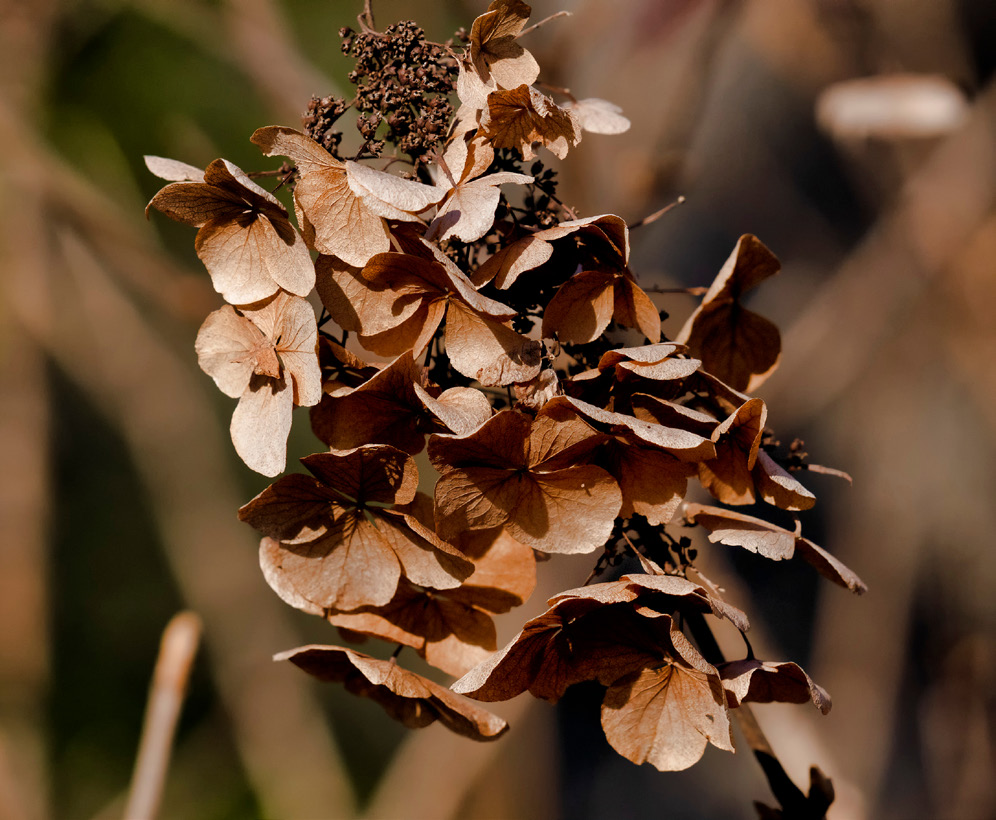A Guide to Selecting, Harvesting and Preserving Woody Ornamental Cuts
Introduction
Woody cuts include unique stems, berries, branches, buds, catkins or flowers that producers or hobbyists can use to make unconventional arrangements (Figure 1). These cuts are becoming increasingly popular as the available plant material is unique and endless. Woody cuts can be harvested from thelandscape in one's backyard or by growers who wish to extend the season, generate extra income during the off season and provide incredible diversity to florists. It is common for the attractive leaves and flowers of an herbaceous plant to be harvested in the summer, but the ambiance that woody cuts provide can be collected year-round. Woody cuts are oftenharvested for several years, as the yields increase each year. This allows growers to save on labor and purchasing costs.
One must consider their climate, market, what to grow,space and facilities needed. Downsides to growing woodies should also be noted prior to incorporating them into an operation. A common drawback to growing woodies that growers should note is the slow return. It is not uncommon for a tree or shrub to take three or more years before it produces harvestable branches, buds or foliage depending on the size of the initial plant, and thus the return on initial investmentis often slower than conventional herbaceous cuts. Florists should also observe the market to determine what cuts would be profitable, what is available and how to preserve or extend vase life. Customers and hobbyists on the other hand, may want to know the qualities a plant has and when to harvest a certain attribute of the plant for their desired use (Table 1). It is important to know what will be profitable when deciding what woody crops to grow. Many customers want fragrant flowers, unique berries, and greenery for the holidays, while florists tend to appreciate both along with unique stem pieces.
| Firethorn | Magnolia | Corkscrew Willow | American Beautyberry |
|---|---|---|---|
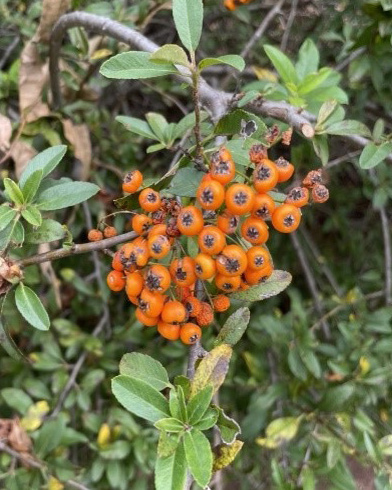 |
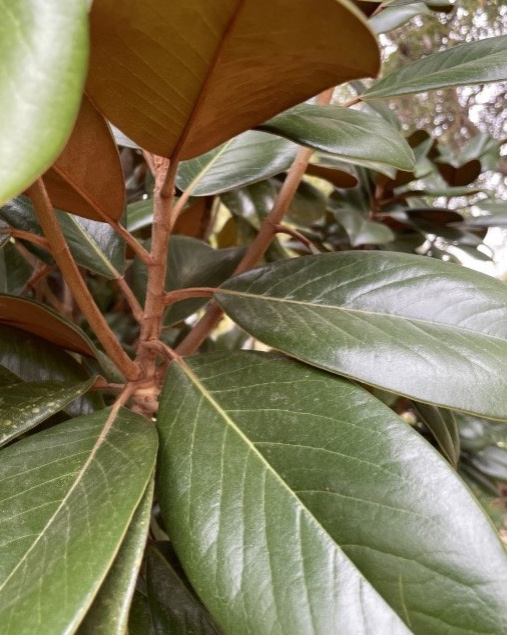 |
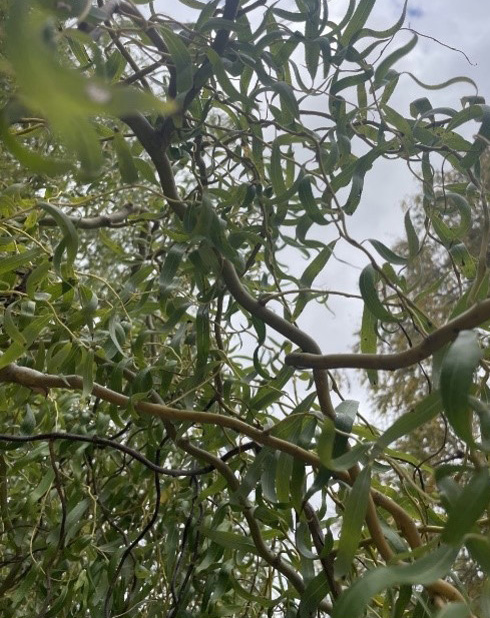 |
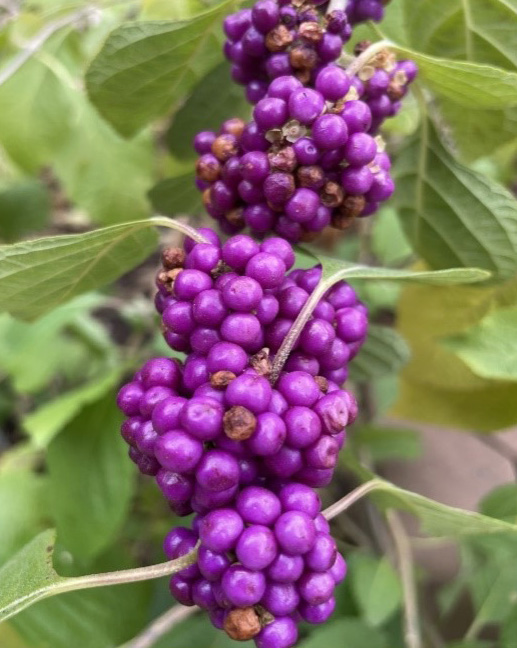 |
| Figure 1. |
Left Two: The brightly colored berries on a firethorn (Pyracantha coccinea) (left) and the unique leaf structure and bark color of a magnolia (Magnolia grandiflora) (right) Right Two: Twisted and curling leaves and branches of a corkscrew willow (Salix babylonica) (left) and the vivid purple fruit produced by the American beautyberry (Callicarpa americana) (right). |
||
| Name | Attributes | Harvest |
|---|---|---|
| Abelia x grandiflora | Variegated foliage, dainty white flowers | Foliage and flowers: June-August; Branches: November-January |
| Aronia arbutifolia | Used for petite white flowers, foliage and berries | Flowers: March-April; Berries: August-October |
| Buddleia davidii | Striking cluster of purple flowers | June-September |
| Buddleia globosa | Spiracles of vibrant orange flowers | June-August |
| Buxus spp. | Used for foliage | year-round |
| Callicarpa americana | Branches with clusters of colorful berries | August-October |
| Calycanthus floridus | Dark red flowers, fragrant | May-June |
| Caryopteris x clandonensis | Small and mounding shrub, deep blue flowers | July-September |
| Celastrus orbiculatus | Brances produce red berries enclosed in a yellow casing | September-October |
| Cercis canadensis | Vibrant blooms on narrow branches | March-April |
| Chaenomeles speciosa | Long branches with multiple red flowers | December-March |
| Chimonanthus praecox | Pale yellow flowers on narrow branches | November-January (may need frost/freeze protection) |
| x Chitalpa tashkentensis | White or pink trumpet shaped flowers | April-September |
| Cornus spp. | Berries, distinctive bark and colorful blooms | Flowers: April; Showy brances: October-November |
| Cotinus coggygria | Dense, smokey plumes | June-September |
| Cotoneaster apiculatus | Compact shrub with an abundance of red berries | April-June, August-September |
| Cytisus scoparius | Fast growing shrub with vibrant flowers | May-June |
| Deutzia gracilis | Panicles of white flowers and showy seed pods when dried | Flowers: April-June; Branches and seed pods: December-January |
| Elaeagnus pungens | Glossy leaves that have a silver hue, white flowers | Leaves: May-August; Flowers: May |
| Enkianthus campanulatus | Creamy yellow and pale pink flowers with vibrant foliage in fall | Flowers: April-July; Foliage: September-October |
| Euonymus japonicus | Variegated foliage | August-September |
| Exochorda racemosa | Masses of white flowers | May-June |
| Forsythia x intermedia | Stems abundant with striking yellow flowers | March-April |
| Fothergilla major | Bottle brush blooms and intense fall foliage | Flowers: April; Foliage: November-December |
| Gardenia jasminoides | Large fragrant blooms | April-June |
| Hamamelis virginiana | Bright yellow flowers | October-December |
| Hydrangea spp. | Large flowers, usually dried | August-October |
| Hypericum fondosum | Mounding shrub with dainty yellow flowers | July-Augus |
| Ilex spp. | Red berries | September-February |
| Illicium floridanum | Dark flowers with strapped petals, fruit is enclosed in a star shaped pod perfect for arrangements and crafts | Flowers: April-May and September-November; Seed pods: March-May |
| Itea virginica | Drooping bottle brush blooms | April-June |
| Kerria japonica | Striking yellow blooms | April-May |
| Kolkwitzia amabilis | Outstanding spring blooms with bell shaped flowers, colorful fall foliage and bark is unique for winter interest | Flowers: April-May; Foliage: September-October |
| Lonicera fragrantissima | Fragrant white blooms | February-April |
| Loropetalum chinense | Fringe-like blooms, dark foliage | February-March, April-May |
| Magnolia grandiflora | Unique foliage, flowers and seed pods; use existing specimen | Flowers: May-June; Foliage: year round; Seed pods: September-October |
| Malus spp. | Deciduous, fruit bearing | September-November |
| Philadelphus spp. | Shrub with medium sized white flowers with yellow centers | April-June |
| Photinia spp. | Shrub with shiny green foliage, new growth is bright red | May-September |
| Physocarpus opulifolius | Tall mounding shrub with whita spiracle flowers | May-August |
| Prunus spp. | Showy tree with white flowers and spectacular fall foliage | Flowers: May-August; Foliage: August-October |
| Pyracantha spp. | Small white flowers and red or orange hued berries | Flowers: April-May; Berries: July-October |
| Rhododendron spp. | Large, vibrant blooms | March-April |
| Rosa spp. | Woody cut for rosehips | September-January |
| Salix spp. | Unique branches across mulptiple varieties | November-March |
| Spiraea japonica | Dense flowers and brightly colored fall foliage | Flowers: April-June; Foliage: August-September |
| Viburnum spp. | Striking clusters of flowers and colorful foliage with berries | Flowers: March-May; Berries and fall foliage; September-October |
| Vitex agnus-castus | Spiked, upright and purple flowers, large growing tree (dwarf forms available) | June-October |
| Weigela florida | Colorful flowers and branches | April-June, August-September |
| Wisteria floribunda | Dense purple flowers that are drooped in nature | May-August |
Table 1. Some plants used for woody cuts, their features, and when to harvest.
Site Selection, Preparation, Planting
There are key factors that must be considered when choosing what woody cuts to grow. These include under-standing your climate and hardiness zone, which crops will extend your growing season, have long stems and those that are known for having a resistance to pests and disease. Customers want species that are unique and have a long vase life. It is recommended that trees and shrubs are grown in rows with a minimum of 8-10’ between each and 10-12’ (will really depend on mature size of plants) between each crop.Having adequate spacing allows for easier harvests androom to fit equipment, such as lawn mowers. Each year, you should mulch each row at a depth of at least 3-4 inches (may be too excessive if done every year; 1-2 inches may be suit able). This cultural practice works to conserve soil moisture, suppress weeds and regulate soil temperature fluctuations. Weeds can arise even if mulching is done properly. Frequentmowing between the rows will help suppress them, too. If needed, a grass-selective herbicide can be applied where grassy weeds are growing.
Young trees and shrubs tend to have limited root systems and need consistent irrigation for the first 2-3 years while the cropis establishing. Hand watering can befeasible if your production space is small, but a drip line is highly recommended if you have multiple rowsofcrops.Manygrowers purchase small trees and shrubs and grow them in a temperature-controlledclimate for many weeks before planting them in the ground in the spring, (April-May). Fertilizers and amendments should be incorporated into the soil prior to planting. Therefore, a soil test should be performed before any crops go into the ground and each year after. This will determine what inputs are needed. Fertilizing the crops can increase harvestable yields and increase the growth rate for many crops. Direct transplanting can also be done successfully after the intense summer heat. The optimal time to plant trees and shrubs in Oklahoma is October-November. When planting, a hole should be dug twice the diameter and around the same depth of the rootball. The crown of the plant should be at the samedepth as it was growing in the container. Additionally, it is best to backfill the hole with native soil for continuity. Some plants, like hollies, are dioecious meaning there are separate male and female plants (Figure 2). Make certain to have a compatible male plant for each female variety. Select pairs that will flower simultaneously to ensure pollination occurs. Holly branches and fruits are long lived; thus, they make an excellent choice for seasonal arrangements and crafts.
Figure 2. A female deciduous holly (Ilex decidua).
Selection and Harvest
Regardless of where the cuts are going and what they’ll be used for, it is important to know what measures need to be taken following the selection of a woody tree or shrub. Many factors, including extended vase life and increased quality, can be expected if all the following are taken into consideration. In general, most woody cuts will last 7-14 days or longer depending on the stage of harvest and post-harvest care.
Harvest Stage
One of the most important aspects of harvesting is thetime of day. Cuts made during early morning hours will be more turgid or full of water. On the other hand, stems cut late in the afternoon contain greater amounts of carbohydrates(sugars), a factor that influences vase life; greater vase life can also be achieved with commercial grade preservatives. Inspection of the entire plant prior to harvesting is crucial,poor-quality stems, imperfections and disease can all be easily identified. If these are avoided, market sales, customer satisfaction, vase life and overall quality will be improved. Theharvest stage and recommendations for each species are all different and dependent on which part of the plant is being cut. For example, most stems used for foliage will wilt almostimmediately after cutting unless they have been hardened off, a process where plants have been acclimated to other ambient conditions. Additionally, some foliage plants, suchas boxwood have been naturally hardened during summer months and are cut in late fall and early winter. Stems should always be cut at a 45-degree angle when harvesting, thispractice increases surface area and increases water uptake. Never remove more than a third of a plant each year when harvesting.
Pruning
Pruning a woody cut for floral uses is much different. than pruning a crop in the landscape. Typically, pruning is used to tidy up an overgrown plant to fit an area. The goal for stem production is to apply pruning methods that encourage more vigorous growth. Rejuvenation, or coppicing, is a pruning method that involves cutting all plant material to theground. Many deciduous trees and shrubs, which go dormant, respond to rejuvenation pruning by producing vigorous stems the following year. Evergreen trees and shrubs that do not gocompletely dormant are not suitable for rejuvenation pruning, instead, only prune old and unproductive growth. Pruning out undesirable stems, such as short or blemished stems, will allow the plant to focus more energy on flowers and growth of desirable stems.
Sanitation
As with all horticultural practices, it is important to use sterile clippers, storage equipment and clean water to prevent pathogens from reducing stem quality. A typical solution for washing materials is a 10% bleach mix. Soak all pruning tools before and after pruning each individual plant to prevent cross contamination and minimize the risk of disease or spreading viruses.
Storage
A general rule is to remove the lower one-third of foliage on every stem to prevent contaminants in the water.If a cut is to be used for its flowers, it is recommended to cut them before they have started budding, floral preservatives are then used to facilitate flower opening. This prevents spent flowers when transportation and pick up times may be delayed for growers and producers. Typically, stems are cut in the winter months at peak color time, for example, thepopular stems of red twig dogwoods are cut as soon as they become vibrant in color. Plants used for unique stems and branches typically have a longer period of harvest. Some plants, such as eucalyptus or hydrangeas are dried and preserved for arrangements.
Reducing field heat following harvest should be doneas soon as possible to extend quality, the best way to accomplish this is to move all cuts into cold storage right away. The optimal holding temperature for woody speciesis around 32˚F, with few species exceptions such as willows and forsythia which can be stored at 29˚F. Knowing where the woody plant is native to is important, as tropical plantsmust be stored at warmer temperatures, at around 50˚F. In addition, most woody cuts need to be stored in high humidity (95%). A humidifier or misting system can be added to the storage area if this percentage is hard to maintain.
Post-Harvest
Water quality refers to the cleanliness and pH present. pH level is the measurement of the acidity and alkalinity of water on a scale of 1 (acid) to 14 (alkaline), with 7 being neutral. Most tap water is near neutral, and acidity can be obtained using a commercial floral preservative. Acidic wateris taken up more readily by flower stems than is neutral or alkaline water. A pH between 3-5.5 is recommended, but a pH over 6 may decrease vase life in many woody species.To ensure the stems are placed in the optimal pH range, keep pH test strips handy. These are affordable and easy to read. If the pH is too high, adding phosphoric or citric acid will lower it. Commercial grade product brands, such as GeneralHydroponics, sell premixed pH raising and lowering solutions. Total dissolved solids (TDS) refers to the measurement of water salinity, dissolved solid or soluble elements in water. The dissolved solids in water can include magnesium, sodium, calcium, chlorides and sulfates. Total dissolved solids in water are measured in parts per million (ppm), high quality water should have a TDS measurement of less than 200 ppm. In addition, soft water high in sodium or drinking water high in fluorides may be harmful. It is recommended that thewoody cut be placed in warm water (110˚F) immediately after harvesting. Post-harvest solutions can be used for branches
that are flowering (Table 2).
| Solution 1 | Solution 2 | Solution 3 |
|---|---|---|
| 30mg silver nitrate or silver thiosulfate | 800mg aluminum potassium sulfate | 20ml ethanol |
| 30mg Streptomycin sulfate or another antimicrobial agent | 200mg potassium chloride | 34-68g sucrose |
| 200mg citric acid | 200mg sodium chloride | |
| 100mg boric acid | 30g sucrose | |
| 1ml glycerin | ||
| 30g sucrose | ||
| 50ml cladox filtrate |
Table 2. The following post-harvest woody cut solutions are made for 1 liter of water.
After the flower buds begin to swell in the solution, the stems can be moved to a temperature of 75˚F or 35˚F, the lower temperature can be used ifslowing the rate of the flowers opening is desirable. It is also possible to make homemade preservatives. The most important aspect of formulations is the pH level. Simple ingredients, such as 7-Up and tap water can be used at a rate of 1 equal part each for consumers wanting to extend vase life. Another recommended solution proven to extend vase life is combining 0.5 ounces citric acid and 1 fluid ounce bleach in 8 gallons of water. Do not add bleach if utilizing the 7-Up method, as this will decrease vase life. Stems cut for foliage should not be placed in apreservative solution.
Another postharvest method is pulsing stems, treating flowers with high concentrations of sugars and germicides in a 1-20% sugar solution. Pulsing is another way to encourage buds to open in some species. The stems can be placed in this solution for a few seconds to 8 hours in either warm or cool water. There are various preservatives that can be used to extend vase life. Typically, they include citric acid (to promote root uptake) bactericides (to regulate bacterial growth),and sucrose (sugar) to act as a food source. Concentrations are typically altered based on species, season and type of material. For example, foliage cuts do not respond well toadded sucrose. As for projects, such as dry wreaths, branches from plants (i.e. grapevine) do not need special post-harvest applications and care.
Some species benefit from a process called forcing. Forcing involves cutting when outside temperatures are just above freezing, moving the cuts indoors and gradually introducing them to warm temperatures.Thisisdone to encourage blooms to open earlier than a species would naturally flower. Fruit blossoms, forsythia, flowering quince and pussy willow are examples of woodies cut for forcing.
Ethylene is an odorless and colorless gas produced by flowers, foliage, ripening fruit, vegetables, bacteria and decaying plant material. Ethylene is also produced by car exhaust and tobacco smoke. Different varieties of flowers have different levels of sensitivity to ethylene, ranging from very high sensitivity to no sensitivity; roses, hydrangea and hibiscus for example are all highly sensitive. Ethylene can cause rapid wilting, color fading, blossom drop, bloom shat tering and the early death of flowers. It is important to be aware of and remove woody cuts from sources of high levels of ethylene if species is known to be sensitive, sensitivity is unknown or if ethylene damage symptoms appear.
Dried Arrangements
Dried material, such as branches and foliage from eucalyptus or dried hydrangea flowers are also staples in the floral industry (Figure 3). This type of storage is becoming increasingly popular as dried flowers and stems are cost efficient and require minimal care. Other flowers and stems from woody cuts that are typically dried are azaleas, roses, honeysuckle and viburnum. The practice of drying plantmaterial is simple: make the selection of flowers and stems, harvest, and immediately hang them in a very dark and dry environment for 3-4 weeks. Alternative methods are also achievable, drying recipes can be used such as equal parts borax and cornmeal. This mixture holds petals in place while they dry naturally. Commercially produced drying agents canbe used and are mostly comprised of silica gel. Flowers and silica gel must be placed in airtight containers to prevent the absorption of water molecules from the outside air, this process usually takes 3-8 days. If the plant material is removed too soon, the risk of drooping petals increases. It may be necessary to “bake” the silica out after the material has sat in the mixture. This can be done by placing the flowering stems on a pan and heating them to 250-300˚F for 1 hour. A lacquer spray can be applied to the dried flowers to prevent them from reabsorbing moisture.
Figure 3. An example of a dried Oakleaf hydrangea (Hydrangea quercifolia) flower.
Foliage heavy crops like eucalyptus can be preserved in glycerin. Simply cut the branches to your desired lengthand mechanically smash the bottom portion of the cut stem with a hammer. This allows the mixture to soak into the plant material. In a small pot, combine two parts water to one part vegetable glycerin and bring the mixture to a boil. Place the solution into an airtight jar and begin adding the eucalyptus. Store the vase in a dark environment for 2-6 weeks. More glycerin may be added as the stems are quick to absorb the solution. Once fully dried, the eucalyptus pieces can beremoved and are immediately useable for an arrangement. Other woody crops that are suitable for the glycerin technique include junipers, magnolias, oaks, spirea and weigela. Notethat foliage color is apt to change once submerged. Some woodies, such Protea, can be stored for multiple years. To store Protea, simply place the stems in an empty bucket where the environment is dark and dry. Expect the blooms to fade in color.
Conclusion
It is evident that the floral industry is constantly expanding. Growers, producers and consumers are frequently exposed to new varieties of woody species. Learning how to harvest and use non-traditional parts of a plant can increasesales, add contrast to existing arrangements and drive customer satisfaction. Researching the woody plant you intend to cut and use is crucial as plants can exhibit varying growthand harvest needs and may not be adapted to certain parts of the state. It is worth noting that starting up a collection may be cost prohibitive for woody cuts unless a grower alreadyhas access to established plants. Recommendations and requirements are vast, but simple aspects of woody cuts, such as general harvest and post-harvest guidelines, learning plant attributes and season of interest, will set individuals apart in this rapidly expanding industry.
Resources
Flower Arrangements. Fact Sheet HLA-6407.
The Care and Handling of Cut Flower HLA-6426.
Soil Testing, The Right Frist Step Toward Proper Care of your Lawn and Garden (L-249).
Woody Cut Stems for Growers and Florists: Production and Post-Harvest Handling of Branches for Flower, Fruit, and Foliage. 2008. Lane Greer and John Dole (Ed.) Timberlin Press (OR) p. 1-512.
Bachmann, Janet. 2002. “Woody Ornamentals for Cut Flower Growers - Western Nevada College.” Woody Ornamentals for Cut Flower Growers.
Bradley, Lucy, and Barbara Fair. 2022. “11. WoodyOrnamentals.” NC State Extension Publications. Accessed November 1. https://content.ces.ncsu.edu/extension-gardener-handbook/11-woody-ornamentals.
“Growing Woody Cut Branch Crops [Fact Sheet].” 2021. Extension. https://extension.unh.edu/resource/growingwoody-cut-branch-crops-fact-sheet.
Kaiser, Cheryl, and Matt Matt Ernst. 2017. “Woody Cuts.”Woody Cuts | Center for Crop Diversification. University of Kentucky.


